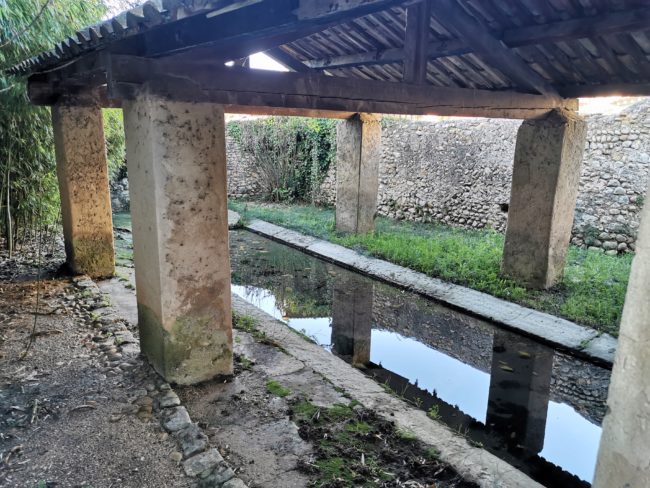
N°8 - Fontaine - Lavoir de Font Achard
Trois sources alimentent cette fontaine-lavoir dite de Font Achard. Un mur arrondi protégeant un réceptacle de 4 mètres de profondeur, un lavoir surmonté d'un toit et une canalisation évacuant les eaux, forment cet ensemble.
Figurant au cadastre de 1495, le site initial comportait une fontaine, un bief et un vivier. À cette époque Claude de Tournon, évêque de Viviers et prince de Donzère (décédé en 1542), se l'approprie, et fait clore sa propriété : d'où le nom de clos ou Enclos du seigneur, qui désigne encore actuellement le quartier.
Son débit étant irrégulier, la fontaine est en 1728 utilisée comme simple abreuvoir. En 1804, la source est devenue abondante. Le lavoir et le toit sont alors réparés. En 1808, l'eau est utilisée par la fabrique d'indiennes installée dans la maison Bouvier (rue Sarcey de Sutières). En 1822, des travaux sont entrepris afin d'irriguer les terres et jardins du voisinage. En 1836 un forage permet d'augmenter le volume d'eau.
En 1878, la source est complètement tarie, d'où la construction du lavoir du champ de Mars. Bien plus tard, les eaux reviennent. Le toit est à nouveau réparé en 1938. Actuellement l'accès au site est fermé.
Three sources feed this fountain-washhouse known as Font Achard. A rounded wall protecting a receptacle 4 meters deep, a wash house surmounted by a roof and a pipe evacuating the water, form this set. Appearing in the cadastre of 1495, the initial site included a fountain, a reach and a pond. At that time Claude de Tournon, bishop of Viviers and prince of Donzère (died in 1542), appropriated it, and had his property closed: hence the name of clos or Enclos du seigneur, which still designates the district today. Its flow being irregular, the fountain was used in 1728 as a simple drinking trough. In 1804, the source became abundant. The wash house and the roof were then repaired. In 1808, the water was used by the Indian factory installed in the Bouvier house (rue Sarcey de Sutières). In 1822, work was undertaken to irrigate the land and gardens in the neighborhood. In 1836 a borehole increased the volume of water. In 1878, the spring was completely dried up, hence the construction of the Champ de Mars washhouse. Much later, the waters return. The roof is again repaired in 1938. Currently access to the site is closed.

